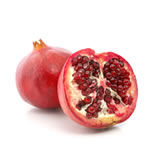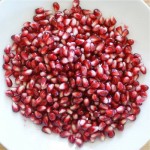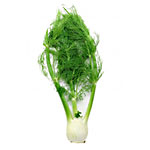Hello All and Happy Friday!
This week’s bins are sure to keep the treats coming long after Halloween! 🙂 We wanted to shed special light on a couple items this week. First, we want to tell you all about the exotic pomegranate! It’s a great fruit filled with nutrients and history!
 Pomegranates are a great source of vitamins C and B and potassium. For those of you who eat the pomegranates edible seeds, you get a high source of fiber and unsaturated oils. They are perfect for snacking, juicing, or sprinkling over your salad for a bejeweling effect.
Pomegranates are a great source of vitamins C and B and potassium. For those of you who eat the pomegranates edible seeds, you get a high source of fiber and unsaturated oils. They are perfect for snacking, juicing, or sprinkling over your salad for a bejeweling effect.
Pomegranates can be tough to approach if you’ve never eaten one before. But no worries! We’ve got the tips to make eating pomegranates super easy! Just keep the wipes nearby. The juice from this fruit will stain your clothes and counter tops!
- Use a sharp knife to cut through the peel of the pomegranate from stem to end. You can score the pomegranate just once or several times into sections. Cut the top off the pomegranate, cutting enough of the top off to reveal the bright red seeds underneath.
- Pull the pomegranate apart into sections – follow the
 sections of the pomegranate as divided by the white pith as much as possible (this is where the fruit will naturally pull apart in most cases). Break the pomegranate sections into slightly smaller pieces for easier handling in the next step.
sections of the pomegranate as divided by the white pith as much as possible (this is where the fruit will naturally pull apart in most cases). Break the pomegranate sections into slightly smaller pieces for easier handling in the next step. - Peel off any sections of membrane that are over the sections of pomegranate seeds.
- Gently rub or “pop” each seed off the pith or inside peel of the pomegranate. Ripe pomegranate seeds will come off the pith relatively
 easily, although you may need to remove a bit of pith at the seeds’ ends where they were attached to the pit.
easily, although you may need to remove a bit of pith at the seeds’ ends where they were attached to the pit. - Each medium size pomegranate will yield about 1 cup of pomegranate seeds.
Secondly, we’d like to shed some light on fennel. It is often in our bins, but can be tricky to use if you’ve never cooked with it before. Fennel is crunchy and slightly sweet. Fennel is composed of a white or pale green bulb from which closely superimposed stalks are arranged. The stalks are topped with feathery green leaves near which flowers grow and produce fennel seeds. The bulb, stalk, leaves and seeds are all edible. Fennel belongs to the Umbellifereae family and is therefore closely related to parsley, carrots, dill and coriander.
grow and produce fennel seeds. The bulb, stalk, leaves and seeds are all edible. Fennel belongs to the Umbellifereae family and is therefore closely related to parsley, carrots, dill and coriander.
How to use fennel: The three different parts of fennel—the base, stalks and leaves—can all be used in cooking. Cut the stalks away from the bulb at the place where they meet. If you are not going to be using the intact bulb in a recipe, then first cut it in half, remove the base, and then rinse it with water before proceeding to cut it further.
Fennel can be cut in a variety of sizes and shapes, depending upon the recipe and your personal preference. The best way to slice it is to do so vertically through the bulb. If your recipe requires chunked, diced or julienned fennel, it is best to first remove the harder core that resides in the center before cutting it. The stalks of the fennel can be used for soups, stocks and stews, while the leaves can be used as an herb seasoning.
What’s New This Week: Along with pomegranates, we have several other items that are new this week! Delicata Squash is a sweet, silky orange flesh squash. If you find it too hard to slice open to remove the seeds when it’s raw, just bake it whole and remove them when it’s soft!
We also have Mixed Heirloom Fingerling potatoes from  our friend Nate at Frog Song’s farm this week. They dense and creamy in texture, and typically require slightly longer cooking time than other potatoes. Use our recipe of the week to really make the best of these taters!
our friend Nate at Frog Song’s farm this week. They dense and creamy in texture, and typically require slightly longer cooking time than other potatoes. Use our recipe of the week to really make the best of these taters!
Finally, we will also have Mishirashu Asian pears! This is another variety that tends to be much larger, and is grown by Dennis O’Neil of Dry Slough Orchards. He is Nate, the potato grower’s Dad, and since his crop was rather small this year, he is selling almost exclusively to us! Such a treat!
As always, if you have any questions or need to get in touch with us over the weekend, feel free to contact us! Also check us out on Facebook and Twitter for the latest on all things New Roots Organics! Have a great weekend! 🙂




